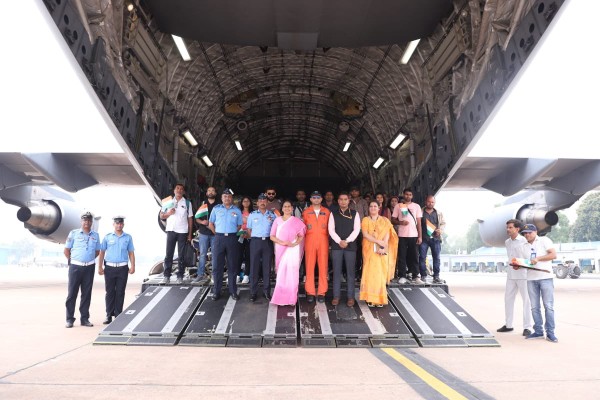India has completed its final evacuation mission under Operation Sindhu, successfully bringing home more than 4,200 people stranded in Iran and Israel following weeks of escalating conflict between the two countries.
The Ministry of External Affairs (MEA) confirmed this on Thursday, describing the operation as one of India’s most complex and diplomatically coordinated evacuation efforts in recent years.
The evacuations, now concluded, were carried out with critical support from Iran, Armenia, Turkmenistan, Jordan, and Egypt, and involved 18 special flights across multiple cities.
In a weekly briefing, MEA spokesperson Randhir Jaiswal, responding to a question from StratNewsGlobal, detailed the final numbers: “We have so far evacuated 3,426 Indian citizens, 11 OCI card holders, 9 Nepalese nationals, 4 Sri Lankan nationals, and 1 Iranian spouse of an Indian national from Iran,” he said.
Due to Iranian airspace restrictions earlier this month, exit points had to be established in Mashhad (Iran), Yerevan (Armenia), and Ashgabat (Turkmenistan). These were used to operate 14 charter flights once Iran lifted airspace curbs on June 20, allowing emergency evacuations to proceed.
Among those evacuated from Iran were students, pilgrims, workers, and 50 Tamil Nadu fishermen who had been stranded in southern Iran. Their extraction became increasingly urgent amid threats of missile strikes and regional instability.
“The cooperation from the governments of Iran, Armenia, and Turkmenistan was vital in granting air clearances and logistical support,” Jaiswal noted.
India also mounted evacuations from Israel, moving 818 Indian nationals to safety. These included students, professionals, and caregivers who were transported by land to Jordan and Egypt, and then flown back via four special flights.
A key leg of this effort involved a C-17 Globemaster of the Indian Air Force, which carried over 400 evacuees from Jordan, while a charter flight took 161 Indians from Amman after a coordinated overland evacuation from Israel.
Operation Sindhu was launched in response to a sharp military escalation between Iran and Israel, which began with Israeli strikes on Iranian nuclear and military infrastructure. Iran retaliated with ballistic missile attacks, prompting a temporary lockdown of its airspace. A fragile ceasefire brokered by U.S. President Donald Trump earlier this week allowed for the final phase of evacuations to proceed.
The first Indian rescue flight landed in New Delhi last Friday with 290 evacuees. Subsequent flights followed through the weekend and into this week.
While no foreign military aircraft were used, India’s efforts were marked by tight regional and international coordination, particularly with countries like Iran, Jordan, and Egypt.
India also responded to appeals from Nepal and Sri Lanka, evacuating several of their nationals caught in the conflict zone.
While the operation has now concluded, Jaiswal stated that further flights would be considered only if the ceasefire collapses or new evacuation requests emerge.
Operation Sindhu adds to India’s growing track record of large-scale evacuation missions — a blend of logistical planning and diplomatic outreach that underscores the country’s expanding role as a crisis responder in volatile regions.
















